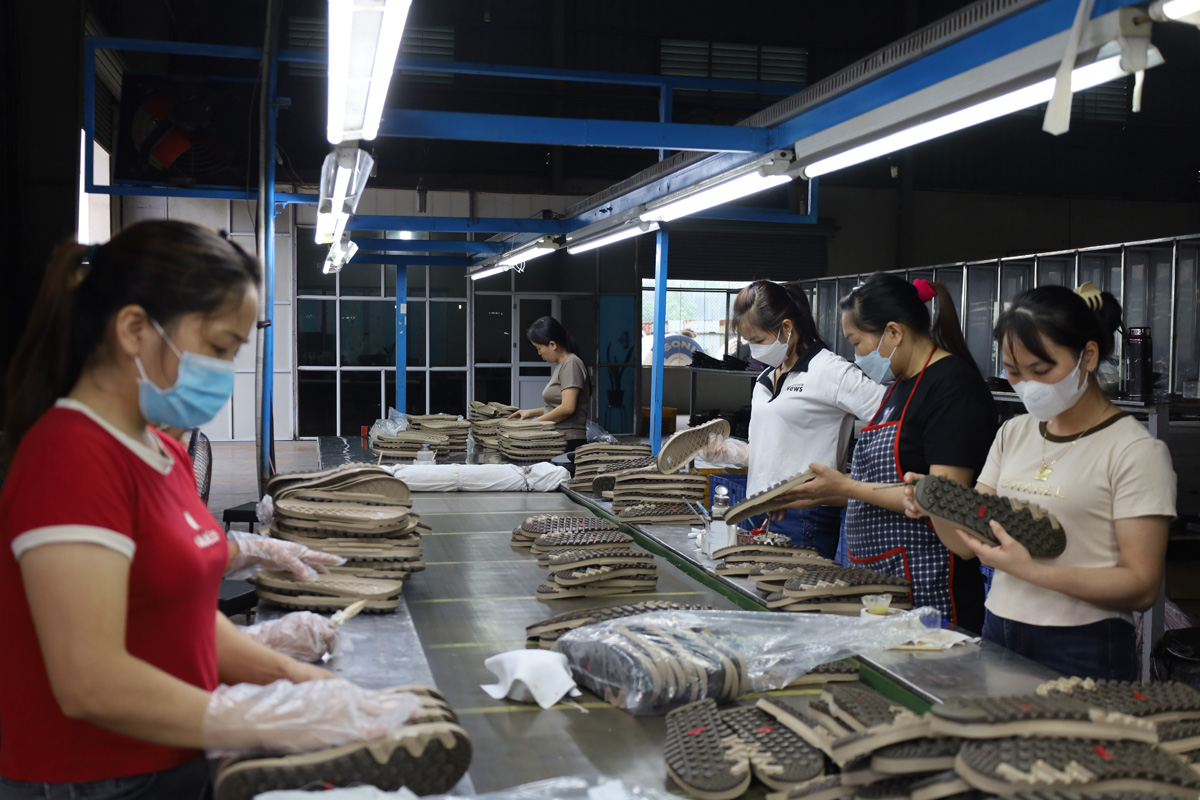
Situated at the gateway to the Northwest, Hoa Binh province has a population of over 900,000, including about 540,000 of working age. It is home to 6,000 businesses and production facilities, providing employment for over 100,000 workers. The remaining workforce is engaged in informal jobs, works in enterprises outside the province, or contributes to agro-forestry-fisheries. Additionally, around 3,000 workers are employed abroad.
Since its
operations in 2023, Hong An Footwear JSC in Lien Son commune, Luong Son
district, has generated jobs to 200 local workers.
A Korean enterprise conducts direct interviews in Da Bac district to recruit
workers for seasonal jobs in the Republic of Korea.
Compared to the period before 2021, the number of workers employed abroad under
fixed-term contracts has surged, particularly in Japan and Taiwan. They are
engaged in various fields, including manufacturing (mechanical engineering,
apparel, footwear, and electronics assembling), construction, agriculture,
fisheries, and caregiving services for the elderly, patients, and households.
Overseas employment offers stable and relatively high income, favorable working and living conditions, and comprehensive welfare benefits. Many young
workers from localities join programs designed to send trainees and workers
to Japan, highlighting the appeal of these opportunities.
In 2024, the provincial Department of Labour, Invalids and Social Affairs
(DoLISA) successfully held a job fair, connecting labour supply and demand. The
event attracted 31 enterprises in and outside the province and over 1,000 job
seekers. Workers were also supported with loan policies to facilitate overseas
employment under fixed-term contracts.
Under the IM Japan
programme, DoLISA coordinated the selection of female technical trainees for
internships in Japan, as well as caregivers and nurses for employment in Japan
and Germany. The department also facilitated the recruitment of workers for 36
businesses targeting markets in Japan, Taiwan, Poland, Hungary, Russia, and
Saudi Arabia. It assisted seven enterprises in recruiting workers for companies
and industrial zones in the province, as well as in Hung Yen province and
Hanoi. It also helped Vietnamese laborers secure jobs in companies and
contractors requiring foreign workers in certain provinces.
DoLISA collaborated to
verify cases of workers fleeing their workplaces abroad, particularly in
Taiwan. Efforts were also made to raise awareness and prevent scams related to
agricultural employment in Australia. The department partnered with other
agencies and local authorities to combat fake information regarding labor export opportunities.
According to data from the Hoa Binh Provincial Party Committee, the industrial production index for the first six months of 2025 is estimated to have increased by 20% compared to the same period last year. This marks the highest year-on-year growth rate for this period since 2020.
In the first six months of 2025, Hoa Binh province’s export turnover was estimated at 1.145 billion USD, marking an 18.11% increase compared to the same period in 2024. Import turnover was estimated at $ 804 million, a 17.15% increase, which helped the province maintain a positive trade balance.
The lives of the ethnic minority farmers in Tan Lac district have gradually improved thanks to the new directions in agricultural production. This is a testament to the collective strength fostered through the professional associations and groups implemented by various levels of the district’s Farmers’ Union.
With the motto the "product quality comes first,” after nearly one year of establishment and operation, Muong village’s Clean Food Agricultural and Commercial Cooperative, located in Cau Hamlet, Hung Son Commune (Kim Boi district), has launched reputable, high-quality agricultural products to the market that are well-received by consumers. The products such as Muong village’s pork sausage, salt-cured chicken, and salt-cured pork hocks have gradually carved out a place in the market and they are on the path to obtaining the OCOP certification.
In the past, the phrase "bumper harvest, rock-bottom prices" was a familiar refrain for Vietnamese farmers engaged in fragmented, small-scale agriculture. But today, a new spirit is emerging across rural areas of Hoa Binh province - one of collaboration, organisation, and collective economic models that provide a stable foundation for production.
Maintaining growing area codes and packing facility codes in accordance with regulations is a mandatory requirement for agricultural products to be eligible for export. Recently, the Department of Agriculture and Environment of Hoa Binh province has intensified technical supervision of designated farming areas and packing facilities to safeguard the "green passport" that enables its products to access international markets.




